“You wanna know how to get Capone? They pull a knife, you pull a gun. He sends one of yours to the hospital, you send one of his to the morgue. That’s the Chicago way! And that’s how you get Capone.”-Sean Connery to Kevin Costner
Sean Connery. Kevin Costner. Brian De Palma. Ennio Morricone. Could it be possible that each of these artists—two actors, a director and a film composer—did their best work in The Untouchables? It’s possible. Not likely. Still——
The opportunity to judge for yourself is now at hand in some bang-up new Blu-ray releases from Warner Bros., officially available May 21, two volumes in the “Ultimate Gangster Collection.” One set, the “Classic Collection,” represents, some might say, the cream of black-and-white in this genre, from 1931 to 1949, climaxed by James Cagney’s White Heat. The other set which includes three other films, The Petrified Forest, Little Caesar and The Public Enemy arrives under the “Contemporaty” moniker. Both are available on Blu-ray 5/21. Thanks to Warner Brothers for the review copy provided.
The second set, the “Contemporary Collection,” is just as “creamy,” albeit much, much bloodier, thanks to the vivid color and the immense “progress” made in the name of realism. These five gangster movies were made between 1973 and 1995. In order of creation, they are Mean Streets,The Untouchables, GoodFellas, Heat and The Departed. Were it not that all but two of the films are directed by Martin Scorsese and all but one stars Robert De Niro, this could be regarded as a first-rate tribute to these two men. Rather than to any individuals, this set is a first-class tribute to the gangster films of this later period of Hollywood history.
The great wonder of both DVD sets is not, as is usually the case, that the buyer, to use an appropriate metaphor, inherits a dubious gun case with only one or two loaded guns. Congratulations to Warner Bros.! There are no blanks in either of these sets. All are at least three-star films, most of them four, four being tops.
As to that question regarding the convergence of such outstanding talent in The Untouchables, the movie which is the specific interest here, Sean Connery, Brian De Palma and Ennio Morricone were never better. Oscars are sometimes ill-placed, and governed by all sorts of non-acting criteria, but Connery’s Best Supporting Actor award is clearly deserved, even if it were a belated award for accumulative work, which fortunately it is not. That that category was not especially strong in 1987 should not diminish his Oscar. The acting is, indeed, the best of his career.
Kevin Costner was in the middle of his ripest period, with the luck to fall into a cluster of good films, making each role his own. His success had officially begun a few years earlier, in 1985, with Silverado. The Untouchables was immediately followed by No Way Out—a slick thriller, however preposterous the about-face ending—and then, often one after the other, such right-on targets as Bill Durham, Field of Dreams, Dances with Wolves, Robin Hood: Prince of Thieves, JFK and Wyatt Earp
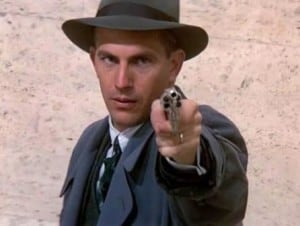 Despite the sometimes lack of the most nuanced of performances, his acceptance from the first has been largely due to his wholesome, boyish appearance and likable personality, a kind of James Stewart successor. Like Stewart, he mostly plays, and is most comfortable as, an easy-going good guy, one of the few exceptions being the serial killer role in Mr. Brooks.
Despite the sometimes lack of the most nuanced of performances, his acceptance from the first has been largely due to his wholesome, boyish appearance and likable personality, a kind of James Stewart successor. Like Stewart, he mostly plays, and is most comfortable as, an easy-going good guy, one of the few exceptions being the serial killer role in Mr. Brooks.
Not that The Untouchables contains Costner’s greatest performance. It doesn’t. The competition, too, is rather tight. He is obviously out shown by Connery, an indomitable presence and a born scene-stealer in any case. Even Charles Martin Smith holds his own and gains sympathy as another nice “good guy,” so much so that the seasoned filmgoer will instinctively sense, “Yep, he’s gonna die before this flick is over.”
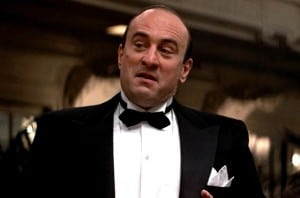 As for Robert De Niro, his always larger-than-life acting well suits this larger-than-life movie. He is variously gripping as the evil Al Capone, from violently malicious when his power is threatened to tearfully sentimental during a performance of “Vesti la giubba” from Pagliacci. His method acting seems to pay off remarkably well here—critics must not be against “the method” when it works!—especially during the “baseball bat” luncheon and his staircase confrontation with Ness, this Federal agent nemesis: “I want him DEAD! I want his family DEAD! I want his house burned to the GROUND!” Since De Niro never has a scene with Connery, the one actor in this flick strong enough to challenge him, the results of that comparison must remain forever inconclusive. For me, however, it’s the Scotsman all the way.
As for Robert De Niro, his always larger-than-life acting well suits this larger-than-life movie. He is variously gripping as the evil Al Capone, from violently malicious when his power is threatened to tearfully sentimental during a performance of “Vesti la giubba” from Pagliacci. His method acting seems to pay off remarkably well here—critics must not be against “the method” when it works!—especially during the “baseball bat” luncheon and his staircase confrontation with Ness, this Federal agent nemesis: “I want him DEAD! I want his family DEAD! I want his house burned to the GROUND!” Since De Niro never has a scene with Connery, the one actor in this flick strong enough to challenge him, the results of that comparison must remain forever inconclusive. For me, however, it’s the Scotsman all the way.
Andy Garcia as another Federal agent, the smallest role of the top five actors, often fades into the background and seems unduly stoic, which, oddly, is a criticism sometimes leveled at Costner’s performance.
DePalma, like his Scottish friend Connery, although more so, turned out a plague of inferior films, in fact a larger percentage of duds than many other directors, say, Billy Wilder, John Ford, William Wyler, Alfred Hitchcock or DePalma’s fellow champion in the gangster/crime genre, Martin Scorsese. Yes, that selective citing of names is a bit unfair: these are, after all, master film directors, the best of the best. Belonging to a lower directorial echelon, DePalma often prefers to copy his fellows rather than originate ideas, most frequently Hitch.
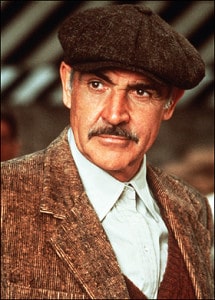 All that aside, The Untouchables is a brilliant aberration, one of De Palma’s finest efforts, supported by the talents of those already mentioned, and, too, by a blending of many other ingredients beyond the director, the stars and the composer. There are, for starters, the superb work of screenwriter David Mamet, cinematographer Stephen H. Burum, film editors Gerald B. Greenbergand Bill Pankow and a trio of art/set designers (Oscar-nominated) headed by Patrizia von Brandenstein, who won her only Oscar two years earlier for Amadeus.
All that aside, The Untouchables is a brilliant aberration, one of De Palma’s finest efforts, supported by the talents of those already mentioned, and, too, by a blending of many other ingredients beyond the director, the stars and the composer. There are, for starters, the superb work of screenwriter David Mamet, cinematographer Stephen H. Burum, film editors Gerald B. Greenbergand Bill Pankow and a trio of art/set designers (Oscar-nominated) headed by Patrizia von Brandenstein, who won her only Oscar two years earlier for Amadeus.
Ennio Morricone, who first gained fame in the 1960s as a composer of so-called “spaghetti Westerns”for Clint Eastwood, has become the most prolific composer in movie history, far more so than his contemporary John Williams, who, really, has no pretensions to the title. Morricone as well has turned out more scores per year—if that proves anything—than the possible previous champ, Max Steiner, though, admitted, many of the Golden Age composer’s early scores were simple main and end titles. By the laws of artistic creation—and the rule sometimes applies even to some works of a genius like Mozart—such over abundance results in a dilution of substance and quality, as is entirely true of much of the Italian composer’s work. However, as Carl Sandburg wrote about Chicago, where The Untouchables takes places, the score is as “big-shouldered” as the rest of the film.
Simply put—hard for this writer; we’ll see—the plot of the movie is this:
A naïve Bureau of Prohibition agent, Eliot Ness (Costner), arrives in Chicago in 1929 to see what he and his Federal agents can do about the gangster and bootlegger king, Al Capone (De Niro), who seems to be running the city and its government, including the police. Killings, corruption and liquor smuggling are rampant. In his first “surprise” raid, Ness finds, not illegal Canadian booze, but oriental parasols. Someone tipped off Capone!
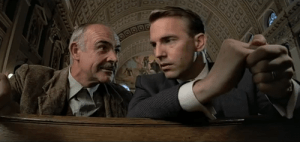 By accident, Ness meets an honest Irish-American policeman, Jim Malone (Connery), on his beat and Ness asks for his help. They meet in a church—one of the few places safe from eavesdroppers—and Ness agrees to do whatever it takes, to go all the way, to get Capone. When Ness wonders where they will ever find any reliable men to join them, Malone, in one of his succinct quips, says, “If you’re afraid of getting a rotten apple, don’t go to the barrel, get if off the tree.” The two men recruit an Italian-American police trainee, George Stone (Garcia), and, needing one more gun, Malone drafts an unwary but instantly fervent accountant, Oscar Wallace (Smith), who has found Capone is four years delinquent on his income tax. Together, the four men become friends and “The Untouchables” as well—incorruptable, totally dedicated to their job.
By accident, Ness meets an honest Irish-American policeman, Jim Malone (Connery), on his beat and Ness asks for his help. They meet in a church—one of the few places safe from eavesdroppers—and Ness agrees to do whatever it takes, to go all the way, to get Capone. When Ness wonders where they will ever find any reliable men to join them, Malone, in one of his succinct quips, says, “If you’re afraid of getting a rotten apple, don’t go to the barrel, get if off the tree.” The two men recruit an Italian-American police trainee, George Stone (Garcia), and, needing one more gun, Malone drafts an unwary but instantly fervent accountant, Oscar Wallace (Smith), who has found Capone is four years delinquent on his income tax. Together, the four men become friends and “The Untouchables” as well—incorruptable, totally dedicated to their job.
At the U.S.-Canadian border, Ness and his three men, assisted by Canadian authorities, successfully intercept a caravan of illegal liquor—in one of the action high points of the film, and in Morricone’s music. In the best way he knows, to coerce a captured Capone bookkeeper (Brad Sullivan) into translating the codes in his ledger, Malone presses up against a window the dead bootlegger Ness had already shot, threatens the man, then “kills” him. The bookkeeper becomes instantly cooperative!
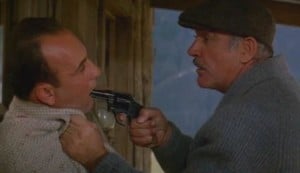 One of Capone’s hit men, Frank Nitti (Billy Drago), infiltrates the police station and kills the bookkeeper and Wallace. While Ness persuades the district attorney not to close the case against Capone for income tax evasion, Malone threatens the police chief (Richard Bradford), a Capone mole, and learns that another gangster accountant (Jack Kehoe) is departing Chicago by train to avoid a subpoena. A knife-wielding hood sneaks into Malone’s street corner apartment. “Isn’t that just like a wop?” Malone says. “Brings a knife to a gunfight.”
One of Capone’s hit men, Frank Nitti (Billy Drago), infiltrates the police station and kills the bookkeeper and Wallace. While Ness persuades the district attorney not to close the case against Capone for income tax evasion, Malone threatens the police chief (Richard Bradford), a Capone mole, and learns that another gangster accountant (Jack Kehoe) is departing Chicago by train to avoid a subpoena. A knife-wielding hood sneaks into Malone’s street corner apartment. “Isn’t that just like a wop?” Malone says. “Brings a knife to a gunfight.”
But the intruder is only a decoy, and is easily run off. When Malone steps into his hall—too late! He is shot in the chest at least twenty or thirty times with a Tommy gun by Nitti from across the alley. It’s a little more than implausible that, hit so many times, Malone could live as long as he does and, to boot, crawl across his apartment!—and still be alive when Ness and Stone arrive and longer still to show them which train the second bookkeeper will take. He then struggles to clasp his Saint Jude’s medallion. Regardless, it’s a good death scene and Connery, of course, does it in grand style.
In capturing the bookkeeper at Union Station, Ness and Stone have a spectacular, surreal gunfight with Capone’s henchmen, choreographed like a ballet and done in stylized slow motion. In a graceful sprint, Stone tosses Ness a much-needed revolver. The idea of the baby carriage bouncing down the staircase, here with a totally unruffled, smiling baby, was lifted from the “Odessa Steps” sequence in Sergei Eisenstein’s 1925 The Battleship Potemkin. The line of rigid soldiers marching down the steps would reappear in 1934, only now in Nazi uniforms, in Triumph of the Will by Hitler’s favorite photographer, Leni Riefenstahl.
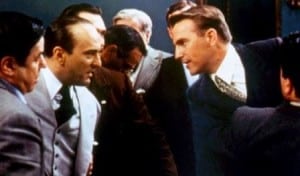 During Capone’s trial for income tax fraud, with the bookkeeper testifying, Ness realizes that Nitti is obviously carrying a gun and escorts him from the courtroom. Ness sees Malone’s address in the inside cover of Nitti’s matchbook and realizes he is Malone’s killer. Trapped, Nitti shoots the bailiff and Ness chases him across the rooftop (reminiscent of In the Line of Fire, Clint Eastwood’s pursuit of John Malkovich) and pushes the killer off the roof when the thug boasts that he is beyond the law.
During Capone’s trial for income tax fraud, with the bookkeeper testifying, Ness realizes that Nitti is obviously carrying a gun and escorts him from the courtroom. Ness sees Malone’s address in the inside cover of Nitti’s matchbook and realizes he is Malone’s killer. Trapped, Nitti shoots the bailiff and Ness chases him across the rooftop (reminiscent of In the Line of Fire, Clint Eastwood’s pursuit of John Malkovich) and pushes the killer off the roof when the thug boasts that he is beyond the law.
Stone shows Ness a list of names from Nitti’s pocket: the jury has been bribed. When Ness threatens the judge (Anthony Mockus, Sr.), implying he also is on the list, the judge switches his jury with the one next door. Capone is convicted and sentenced to eleven years in prison.
Preparing to leave his office, Ness gives the Saint Jude medallion to Stone. The strong bond that had made friends of the four men is somehow commemorated, certainly remembered by the two survivors.
As for Morricone’s score, 1987 was yet another year of blockbusters—Empire of the Sun, The Last Emperor, Lionheart, Robocop and, of course, The Untouchables. But it was a weak year for film scores. The most familiar composers of two of these films, John Williams and Jerry Goldsmith, were experiencing a bit of a slump. Morricone, by far, turned out the best score for The Untouchables, not by default but because it was excellent music and perfectly complemented the film. That it was nominated was fruitless against the tidal wave of Oscars for The Last Emperor.
The Last Emperor, the walk-away winner in nine categories, won Best Original Score, a collaboration of a Japanese, a Chinese and an American. It wasn’t the first, or the last, time a weak score, and, more specifically, one written by a committee, would undeservedly win the Oscar. It happened in 1939 when a group of composers won for a pastiche of American songs for Stagecoach. It could have happened again—remember?—in 2003 when another troupe struggled to assemble music for Master and Commander, though, in this case, fortunately, the score was not even nominated.
(The year 1939 was another year of a muddled distinction between “Best Music, Scoring,” which Stagecoach did win, and “Best Original Score,” which The Wizard of Oz won. But remember, Stagecoach, not an original score, won over Erich Wolfgang Korngold’s Elizabeth and Essex, Aaron Copland’s Of Mine and Men and other original scores which should have been in the category with Oz! Was all that clear?! To make this jumble more ridiculous, between the two categories, there were twenty-five nominees! And then there was the song category . . . )
The entire Untouchables score is permeated with Morricone’s own special flavorings, here adjusted to reflect the era of the’20s and ’30s, Chicago and the types of characters involved, good and bad—a ragtime-like piano, a wailing solo melodica (known under several names, including a key flute), teasing trumpets, sad saxophones and a suave use of strings and percussion.
The music inhabits, generally, three varying sound worlds. One is heard when Ness and Malone enter the bank for a raid with that crane shot of the bustling Chicago street and still later for the fight at the border. The sound suggests the robust romanticism of Korngold and Franz Waxman, of nineteenth-century opulence, though Morricone’s internal style and orchestration, which he does himself (good for him), is quite different.
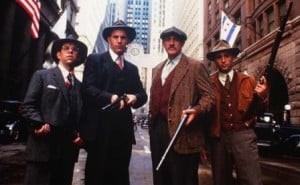 In a characteristic Morriconian contrast, a second kind of sound is one of nostalgia and guarded sadness, a tune in strings and saxophone to represent the friendship of the four “Untouchables,” still, though, with a link to romanticism and comeliness of melody. The theme is also used for the intimate scenes with Ness and his family, his wife (Patricia Clarkson’s début) and daughter (Kaitlin Montgomery).
In a characteristic Morriconian contrast, a second kind of sound is one of nostalgia and guarded sadness, a tune in strings and saxophone to represent the friendship of the four “Untouchables,” still, though, with a link to romanticism and comeliness of melody. The theme is also used for the intimate scenes with Ness and his family, his wife (Patricia Clarkson’s début) and daughter (Kaitlin Montgomery).
That third sound, which conceivably makes the greatest impression because it vividly epitomizes the Morricone style, makes up the rhythms and riffs that support the action sequences, most notably the rooftop chase, the theme for Al Capone, parts of the border music and Malone’s death.
The main title contains such music, and instantly conveys this film is no comedy or musical. This music is saying, “Heads up! Something is about to happen!” After a single jab from the timpani, a regular incessant rhythm is established, to which is added the clanging raps of that piano, followed by an equally jagged ostinato rhythm. It’s all like some kind of wild jazz fugue, with growing complexity and ever-changing variety.
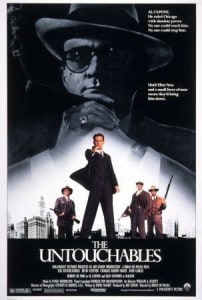
Great, balanced revue of what I think is easily DePalma’s best film.
It’s been a long time since I’ve seen this film, and I think it’s time to see it again. I remember Kevin Costner having a great wardrobe, but he was out-acted by Sean Connery and Robert De Niro.
Great review!
I really enjoyed your analysis of the soundtrack, you have given me a new appreciation of Morricone’s achievement in tailoring the soundtrack to match the music of the period. I am not as fond of the movie, despite the excellent performances of the actors, since the screenplay glorified the Ness character at the expense of the accountant, who actually worked for the IRS, and gathered the evidence to convict Capone without any involvement by Ness. I have to admit, I still enjoy the action scenes though.
I don’t think that Kevin Costner was “outacted” by Connery and DeNiro. If he had been “outacted” by those two, I doubt very much that Hollywood would have considered him star material. When I first saw this film, I immediately knew that both he and Andy Garcia were not only first-rate actors, but also potential stars. I believe that Costner was merely doing his job in portraying Elliot Ness with a little more accuracy than Robert Stack. And I suspect that to do this day, many people are still finding it hard to accept his Ness as the closest to real historical figure. In fact, many actors, to do this day, tend to follow Costner’s template in portraying Ness.
I thought Connery, Martin Smith and De Niro were great in this movie. But when I saw “The Untouchables” the first time, I knew that both Costner and Garcia were going to become stars. And they did.